|
The
wines of Luis Pato, Bairrada
One
of Portugal's winemaking stars
Website:
www.luispato.com
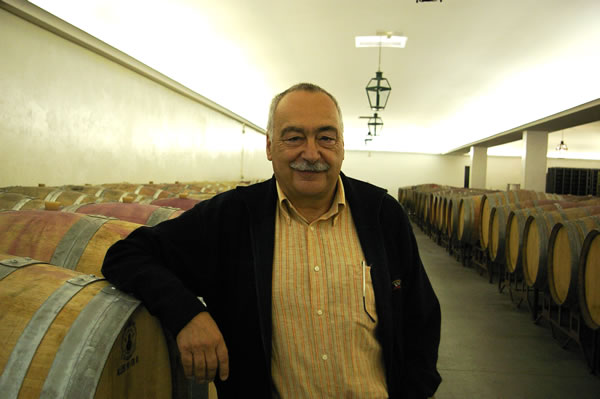
Luis
in his cellar
Luis Pato
(which is Portuguese for ‘duck’) is the best-known producer in
the Bairrada region. He’s widely regarded as the modernizer who
brought a struggling region back to life, but I think it’s unfair
to see him just in this light, because his wines have a traditional
side to them, and he’s also a champion of the local red grape,
Baga. Now that the regulations in Bairrada have changed, allowing
growers in the region to use other varieties, you could say that
Pato is a neo-traditionalist.
Baga has a reputation for
making rather stern red wines, that are unapproachable in their
youth and which often never resolve into mellowness with age. It
also makes sparkling white wines which match perfectly with the
gastronomic specialty of this region – the famous suckling pig, leitão.
While it’s true that Baga can produce rather tannic, fruitless
wines that are tough and somewhat joyless, Pato has shown that Baga
deserves a bit more respect than it’s often given. I find that it
makes wines that share some characteristics with Italian grape
Nebbiolo, and it can even approach the elegance of Pinot Noir in
riper vintages.
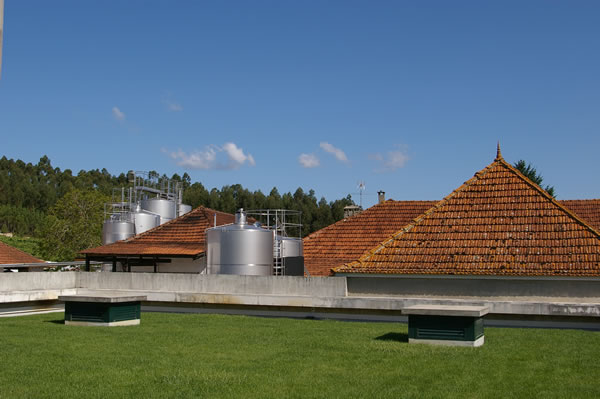
The winery
Pato’s background is that
he trained as a chemical engineer before taking over his parent’s
winery in the early 1980s. As soon as he was up and running, he
began to experiment. He started destemming his wines, which was
unusual at the time, and he began to use small oak barrels, some of
them new. He also blended in some Touriga Nacional. Quickly his
wines caught the attention of the critics. However, since 1999 his
wines have not been labelled ‘Bairrada’, but rather by the
broader designation of ‘Beiras’. Why? ‘The Portuguese
government nominated a guy for the Bairrada head office who was not
the right man’, explains Pato. ‘So to show a yellow card I moved
from Bairrada to Beiras’. Pato cites two reasons why he doesn’t
want to come back to Bairrada. ‘I don’t want to be mixed with
new world style commerce and the use of French grape varieties’,
he says, ‘and I think that the Beiras region needs to be together,
and Bairrada should just be a subregion for the top reds’. [But
the news is that from the 2008 vintage, Pato will be using the
Bairrada appellation for a couple of his wines: the Pe Franco and
the Vinha Formal.]
Pato shows his
open-mindedness in that he was the first overseas judge to
participate in the International Wine Challenge, the world’s
largest blind tasting held in London each year. He describes this
experience as ‘my tasting university’.
Altogether he has assembled 65 hectares of vineyards, and
makes a range of reds, whites and sparkling wines from 20 separate
blocks in various terroirs within Bairrada. His father had 40
hectares, his mother-in-law had 5 hectares, and he has bough 30
hectares, which means that he has rights to another 10 hectares of
vines that currently aren’t planted.
The range is quite complicated, but at its core are four top
reds: the Vinhas Velhas, Vinha Pan and Vinha Barrosa, and the
remarkable Pé Franco, made from ungrafted vines which Pato recently
planted in his Riberinho vineyard. There is also a serious white
wine, Vinho Formal, which has an interesting story behind it. In
1867, António Augusto de Aguiar produced a map showing his Bairrada
demarcation, with a yellow line around the bit he thought was best
for white wines (this is shown: the map is in the Bairrada museum).
Brazil was the important market for Portuguese wines, and for whites
to survive the journey, they had to have the structure of reds. Pato
decided to trust Aguiar’s map and bought the Formal vineyard,
which has chalky clay soils, and the result is this complex,
intense, ageworthy white.
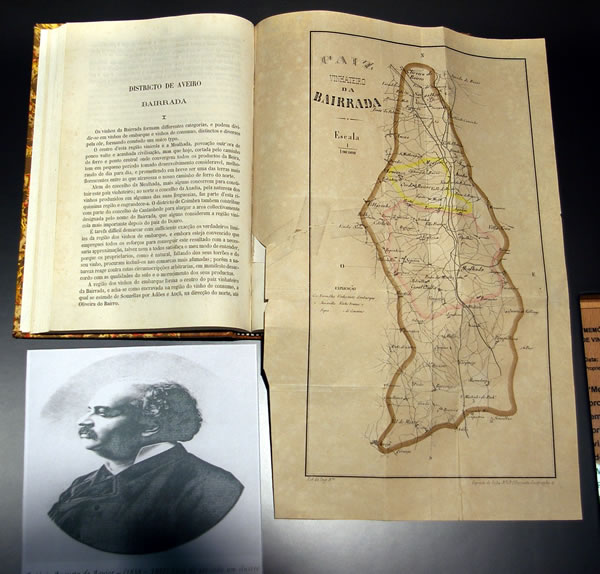
Pato’s latest theme is
that of what he calls ‘precision harvest’. Initially he started
doing a green harvest in 1995, in which he removed a third of the
grapes at veraison. These days he removes half the grapes: one third
at veraison (the usual green harvest), and then later on the balance
between a third and a half. This second harvest, of coloured but not
mature grapes, is used for the sparkling Baga. He’ll pick the
second bunch per stem (the first is the first to grow and is thus
more mature). Luis says that his philosophy is ’old world
tradition blended with new world precision vinification’.
How is the situation in
Bairrada? ‘It’s quite difficult at the moment’, says Pato.
‘Alianca [one of the big producers in the region] was bought by
Bacalhoa a few months ago, and I don’t know whether they will keep
the winery. The cooperatives are going down.’ Pato thinks that the
future may be more positive, though, because while some of the bad,
old fashioned companies are disappearing, new companies are
arriving. ‘The future will be white wines, sparkling wines and
some top reds’. He thinks that to build a good image for the top
Bairrada red wines, just 3% of the best red wines need to be kept.
Luis Pato has three
daughters, and one of them, Filipa, is now a well known winemaker in
her own right. She shares the winery with her father, but makes a
quite separate range of wines from both Bairrada and Dão regions,
as well as some wines with her husband, William Wouters (she married
in summer 2008). Filipa’s wines will be reviewed separately
elsewhere.
The tasting notes below are
from three separate occasions. First, I attended a vertical tasting
of his wines in London at Portal, a high-end Portuguese restaurant
in March 2008. Then in July 2008 I visited Luis Pato at his estate
in the Bairrada. Finally, in November 2008 I tasted through his
wines at a tasting organized by the Independent Winegrowers
Association (a coalition of half a dozen high end estates which Pato
belongs to) at the Bull and Bear restaurant in Porto.
The wines
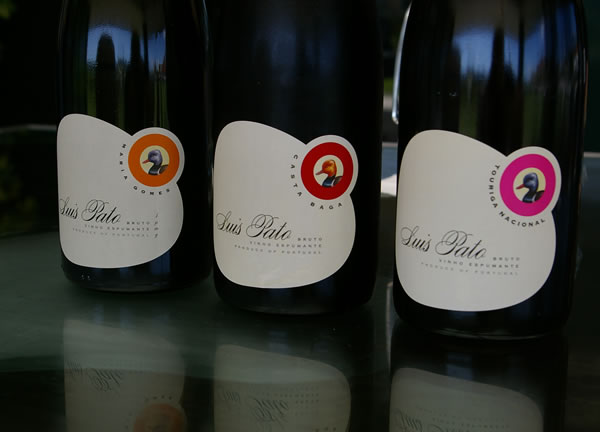
First, the espumantes (these
are all NV, but the wines here are from the 2007 vintage).
Luis Pato Sparkling
Touriga Nacional Rosé
The first harvest of this new sparkling wine (espumante). Light pink colour. Very bright, fruity nose leads to a
fantastic sweet strawberry fruit palate with great precision and
high acidity. 88/100 (03/08)
Luis Pato Sparkling
Touriga Nacional Rosé
Bright, smart and fresh with a lovely strawberry edge to the
sweet fruit. Nice fresh acidity. Quite delicious fruity. 88/100
(11/08)
Luis Pato Sparkling Baga
Rosé
Bright pink colour. Fresh, fruity nose with a subtle herby edge.
The palate is quite zippy but there’s some breadth here. Quite
rich. Nice. 87/100 (03/08)
Luis Pato Sparkling Baga
Rosé
Gentle pink colour. Sweet, bright and characterful with bright,
fresh berryish fruit and a bit of sweetness, too. Delicious. 90/100
(11/08)
Luis Pato Maria Gomes
Aromatic, sweet melony nose with lovely ripe fruit. The palate
is fat and broad with a smooth texture, and some freshness on the
finish. Pure, elegant fruit here. 88/100 (03/08)
Luis Pato Maria Gomes
Beautifully aromatic with sweet, fresh, grapey floral nose.
Fresh and bright and fruity on the palate. Beautifully grapey and
sweetly fruited. 89/100 (11/08)
Luis Pato Vinhas Velhas Branco 2007
Lovely bright, fresh, slightly nutty style with nice herby
freshness, and also some breadth. A complex, full flavoured white
with nice depth and texture. 90/100 (11/08)
Luis Pato Vinhas Velhas
Branco 2007
Broad nose is expressive, combining fresh citrussy fruit with
some richness. The palate is fruit driven with broad yet fresh fruit
and oak in the background. 89/100 (03/08)
Luis Pato Vinha Formal
2007
From the Bical variety grown on chalky clay soil. Very rich,
aromatic nose with slightly grapey tropical fruit as well as toasty
richness and a high-toned lemon oil character. The palate is bold
and intense with rich, rounded fruit as well as some nutty richness.
Lovely. 92/100 (07/08)
Luis Pato Vinha Formal
2005
Deep yellow colour. Fantastic bold, aromatic nose with striking
minerally, stony citrussy notes plus some tight vanilla oak. The
palate is structured with high acidity, toasty notes and a strongly
mineralic edge. Complex, powerful and bold with real intensity.
93/100 (03/08)
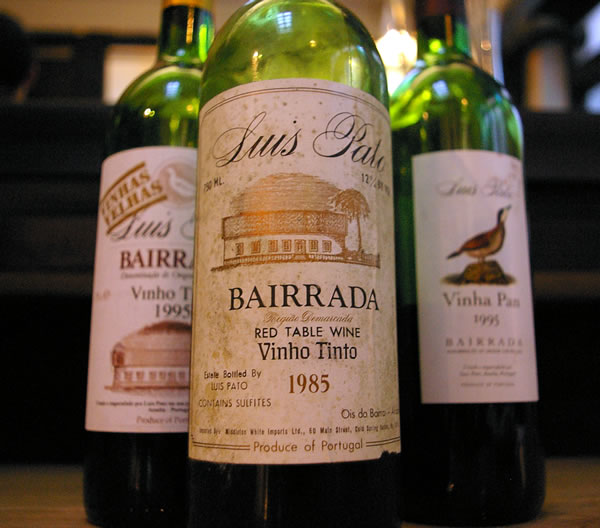
Luis Pato Bairrada 1985
Luis’ first vintage was 1980, but this was the first vintage
in which he destemmed and used new oak. This is one of the 10
bottles he has left! Dark coloured, with a browning rim. Evolved,
perfumed nose shows sweet, slightly stewed fruit with earth, spice
and caramel. The palate is old-tasting with earthy, spicy notes.
It’s slightly stewed but still alive, with some structure. 89/100
(03/08)
Luis Pato Vinhas Velhas
Tinto 2005
Lovely focused broad dark cherry and black fruit nose. Spicy,
complex and intense. The palate has nice fresh savoury dark fruits
with great intensity and an earthy spiciness. This delicious wine is
dense and structured with good acidity: should age well. 92/100
(03/08)
Luis Pato Vinhas Velhas
Tinto 1995
Matured in new and used French oak, this is a wine that’s made
to be more approachable than the Vinha Pan. Deep coloured. Fantastic
sweet, cedary, warmly spiced nose with a balsamic note. Slightly
olive-like. The palate is evolved but still alive, with earthy,
warm, spicy character. Deliciously open, but drink up soon. 90/100
(03/08)
Luis Pato Vinha Pan 2005
Brooding, focused nose is dark, spicy and elegant with black
cherry and black fruits. Incredibly tight and complex. The palate is
open and expressive with elegant dark fruits, good acidity and a
lovely fine yet grippy tannic structure. Wonderful stuff for long
ageing. 94/100 (03/08)
Luis Pato Vinha Pan 2003
Warm, ripe nose is sweetly fruited but with a spicy, earthy
seriousness. The palate is sweet and dense with some tannic
structure and lovely complexity. There are some tannins here, but
they are quite smooth. Expressive. 92/100
Luis Pato Vinha Pan 1995
Very deep coloured. Lovely complex, open, spicy earthy nose is
brilliantly perfumed and really lively. There are some warm cedary
balsamic notes, too. The palate is dense and forward with some
firmness and a lovely earthiness. Still quite tannic and full: a
lovely complex wine that has aged really nicely. 93/100 (03/08)
Luis Pato Vinha Barrosa
2005
Very deep coloured. Tight, bright, focused cherry fruit nose is
aromatic with a hint of mint/eucalyptus. The palate is elegant with
lovely fruit purity. Expressive berry/cherry fruit with grippy
tannins. Lighter than the other wines in character, this is elegant
and should age well. 93/100 (03/08)
Luis Pato Vinha Barrosa
2005
Sweetly aromatic with lovely full blackcurrant and blackberry
fruit. The palate is dense with sweet, pure ripe fruit backed up by
spicy structure. There’s a subtle minty freshness, which makes me
think of eucalyptus. Apparently, the vineyard is surrounded by
eucalypts. 91/100 (11/08)
Luis Pato Vinha Barrosa
2003
Aromatic, expressive red fruits nose with a fresh minty,
eucalypt edge. There’s some savoury, fresh structure to the palate
which is expressive with bright tannins. Quite Burgundian, with good
acidity. 93/100 (03/08)
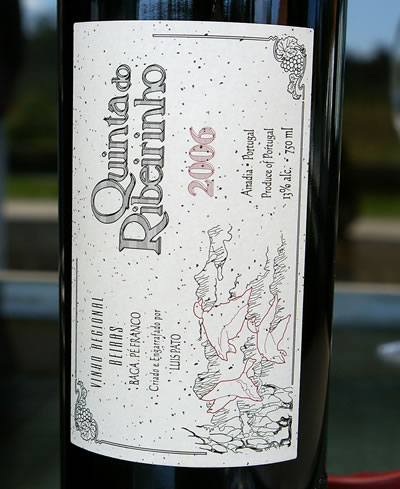 Luis
Pato Quinta de Ribeirinho Pé Franco 2005 Luis
Pato Quinta de Ribeirinho Pé Franco 2005
This is made from ungrafted Baga that Luis planted in one of his
vineyards, and it’s his top wine. Wonderfully sweet, elegant nose
with beautifully framed red berry and cherry fruit with startling
elegance. The palate is concentrated and dense but shows elegance
and poise with well integrated oak and good structure. A serious
effort that should age magnificently. 94/100 (03/08)
Luis Pato Quinta de Ribeirinho Pé Franco 2006
Lovely aromatic nose of dark cherry and spice with lovely
freshness and a subtle earthy complexity. The palate is vivid and
dense with real elegance to the berry fruit, as well as firm, dense
tannins. Fresh, complex and structured with huge potential. 94/100
(07/08)
Luis Pato Quinta de Ribeirinho Pé Franco 2006
Intense, fresh, spicy nose with pure, focused black fruits and
some fine spiciness. The palate is rich and intense with lovely
structure under the dense fruit. Amazing structure and complexity.
Not an easy wine, but a profound one. 94/100 (11/08)
Luis Pato Quinta de
Ribeirinho Pé Franco 2007 (cask sample)
Very deep red/purple colour. Lovely aromatic nose with vivid spicy berry
and raspberry fruit. Concentrated, elegant structured palate with
great purity of fruit. Really fresh. 92–94/100 (07/08)
Luis Pato Quinta do Pôpa Tr e Pa 2007
From barrel, this is a blend of Bairrada (Baga) and Douro (Tinta
Roriz), and it is a new wine. Rich, chocolatey, spicy dark fruits
nose. The palate has a bit of spicy bite as well as soft dark
fruits. Nice stuff. 88–90/100 (07/08)
Wines tasted 03/08, 07/08, 11/08
see also: a much earlier write up of his wines here
Find these wines with wine-searcher.com
Back
to top
|

